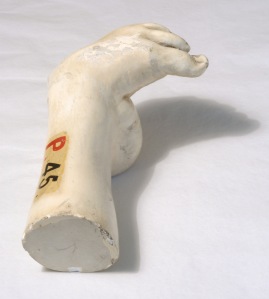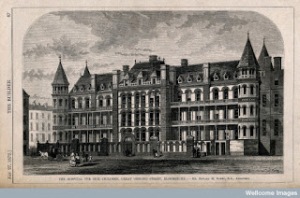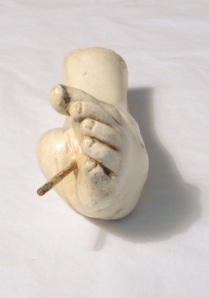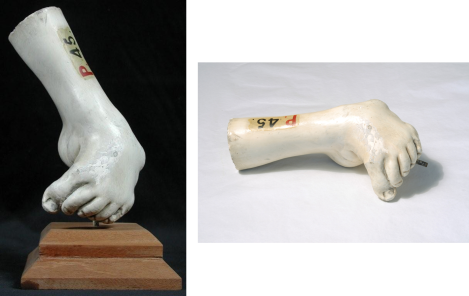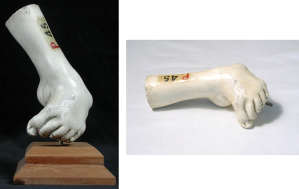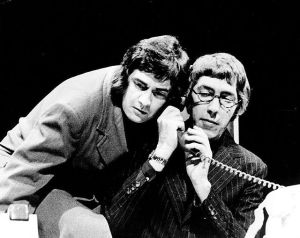After the 100 Hours meetings of 2013-14 had been completed, Leonie Hannan decided to conduct a series of conversations with others, focused on her chosen object – the plaster cast foot from the Pathology Collections at UCL. Summaries of these conversations appear below. Leonie chose to speak with colleagues who, through their work, were interested in collections and research but who had not been involved in the 100 Hours research. The other stipulation was that the conversations should be with people Leonie knew well, so that the potential benefits of familiarity amongst researchers (as well as between researchers and the objects of their study) could be explored further.
CONVERSATION #1 Joey O’Gorman & Leonie Hannan
On Thursday 22 May 2014 I met with Joey O’Gorman, who is a researcher based at Central St Martins working on art and science, to discuss my object: a plaster cast of a child’s foot from the Pathology Collections at UCL.
Through 100 Hours, I have found that conversations about research can become much more fruitful when the participants meet regularly and have got to know one another. On this basis I wanted to explore my chosen object with a series of people I know well – individuals who might also bring to bear their own perspective on the study of material things. In this case, my partner in conversation had a background as a research scientist and has since developed an art practice focused on the use of visual representation and personal meaning-making in the understanding and production of knowledge in molecular biology and ecology. I was keen to see what Joey’s first impressions of the plaster cast were and to see where our conversation might lead me in terms of my research on the plaster cast foot.
But first, the foot. Like the other 100 Hours researchers, I chose this object last September and have been returning to it ever since to study its physical form and deduce something of its history and meaning. Through a series of posts I will introduce my object and draw connections between the path of my own research and the insights I gather through conversation with others. The conversations are held in the Rock Room at UCL, the plaster cast foot sits on the table and a friend and I will be present each time to discuss what is in front of us.
But what is in front of us? To give a bit of background: the plaster cast is part of a collection of 79 casts that were made for a museum in the Great Ormond Street Hospital between circa 1870 and 1910. The plaster casts show disorders that were affecting the child patients the Hospital sought to diagnose and treat and were probably created as a point of reference for medics in training. The disorders illustrated in plaster include familiar illnesses such as Spina Bifida and Rheumatoid Arthritis and also many illnesses that were prevalent in Britain before twentieth-century advances in living conditions and medical treatment, such as Rickets, Cleft Palate, or deformity caused by Tuberculous or un-united fractures. The cast I have chosen is one of several that represent Talipes (equino varus), or ‘club foot’. The plaster casts sit within a collection at UCL that also includes human tissue specimens and these objects relate to a documentary archive which remains at the Hospital and includes case notes, post mortem data, and – in some cases – photographs of the patients. It is an incredibly extensive collection with huge research potential. As I am trained as an archival historian, it has been interesting to tackle this huge collection from the starting point of the cast instead of the many shelves of archival material held at the Hospital.
First Thoughts:
To get started, I asked Joey what his first impressions were of the cast: “Cramp, cramping, cringe response, a flinch in pain or a reflex action.” There is a metal strut pointing out of the sole of the foot, which had previously attached the cast to a wooden stand. I have always seen the metal strut in these terms, but Joey noted the: “stabbing motion of the metal and the pained response of the curled foot”.
Joey thought that at first glance the cast, lying on the table, seemed more like a hand than a foot. He also said that he thought the curve of the foot looked at first like a temporary reflex, but on closer analysis – the projecting bumps along the top of the foot suggested a more lasting deformity.
For me, the deep wrinkles in the sole of the foot (a manifestation of the disorder) made me think about human skin and these fleshy creases also prompted thoughts of the child whose foot this cast represented. I cupped the foot in the palm of my hand and, again, this made the child feel much more present.
From Joey’s immediate reaction to the physical features of the object, our conversation roamed more widely – connecting first impressions with intellectual frameworks and contextual knowledge. This process mirrored our first 100 Hours meeting with Ludovic Coupaye, when he led us through a physical description of the object before allowing a discussion of its context and meaning.
After Consideration:
J: “It has something sculptural about it – the texture of the paint on the plaster ground gives a suggestion of Classical sculpture or an art object. When you focus on these aspects the disorder recedes.” “It also reminds me of a bound foot, the squared off angles and the boxiness of the form.”
I told Joey about what I had found out about the plaster treatment that patients with club foot received – the foot was encased in a plaster cast in order to encourage bones and ligaments into a normal position. This treatment is still used today. So the object we are looking at, which was modelled on the foot itself in order to illustrate the features of a particular disorder, is also reminiscent of the experience of that patient – who was most likely treated with plaster to correct the alignment of the bones in their foot.
J: “So, on the one hand there is the plaster treatment to correct and, on the other, there is the plaster cast model – to capture a static record of a deformity. I suppose this is a reminder that medical science is based in practice.”
Joey was struck by the anonymity of the cast in a way that I have not been. He saw the number it had been given as a substitute for a more personal name and related this to the perception that medical treatment in institutions can seem de-personalising. “You are a case, not a person”. For me, the foot is incredibly personal – made, as it was, through contact with a child’s foot, made in that particular foot’s image. When I began to read the case notes in the Hospital archive, the personal details I found about patients and their families, their physical condition, reinforced the personal nature of the artefact – despite the fact that I could not locate the child in the records that this model foot was based upon. Conversely, Joey dwelt on the emotional distance that is needed to deliver medical treatment, “a scientific objectivity that appears to clash with personal details and the intimate nature of how the cast was made.”
J: “Categorisation in science and medicine is often accused of being reductive. But bio-medical approaches to science and health are not necessarily de-humanising in the end because its application affects an individual’s care. But, of course, there is the notion within Western science and medicine that the body is a machine to be fixed, when parts become broken.”
I asked Joey if he thought the talipes or ‘club foot’ felt alien to us from our twenty first-century perspective? Joey thought that the cast certainly made him think about how we check for signs of talipes in the early months of a child’s life and are, consequently, better able to treat it. “Children’s first steps are a developmental phase that is closely monitored.” I feel like the nineteenth-century context of this object makes it symbolic of progressive, novel medical treatment and the specialisation in treatment of childhood illness. The object also presents us with the specific history of Great Ormond Street and the process of medical advance being institutionalised and systematised.
To conclude our conversation, Joey reflected on the cast as an art object. He focused on the difference between viewing the object vertically (on its stand) and horizontally. “From an aesthetic point of view, these two postures have two completely different characters. Upright, the foot is balletic, elegant, active and invested with agency and movement; laying down, it is prone – it looks passive and infirm.”
Joey has seen things in this object that have not occurred to me, despite many hours of looking. I am looking forward to my second Object Conversation with Sarah Wilkes of the Institute of Making and to finding out more about someone else’s reactions to the materiality of this plaster cast foot.
CONVERSATION #2 Sarah Wilkes & Leonie Hannan
On Wednesday 11 June, I met with Sarah Wilkes – an anthropologist at UCL whose research specialises in materials and sustainability to see what she thought about my plaster cast foot from the Pathology Collections at UCL. I know Sarah from her work at the Institute of Making, where she has been experimenting with bringing interdisciplinary groups of researchers together around the themes of materials and making. So, in many ways, Sarah and I had a lot to talk about.
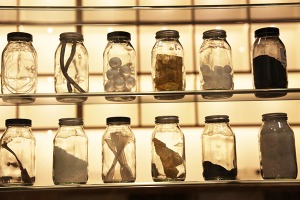
Materials Library, Institute of Making, UCL
http://www.instituteofmaking.org.uk
As before, I was keen to find out what Sarah’s first impressions were of my object before I briefed her on what I knew about its purpose and history. Her first question was about its material construction. Sarah guessed that it was made of plaster, detected a white wash or lacquer coating and commented on how, despite her understanding of it as plaster, the foot had an almost plastic-y appearance.
Next: how was it made? Sarah wondered about whether the metal prong related to the casting of the object. She wondered if it was indeed a cast or, instead, an artist’s free-hand impression of a foot. On balance, Sarah felt that this was a cast that had experienced some further embellishment by its maker.
The conversation moved quickly from the particulars of material and technique to the effect of the object on the person, Sarah commenting that ‘the colour’s a bit sickly, a bit waxy – it has an unhealthy look.’ Perhaps it was the object’s status as an anatomical model that prompted this reflection on waxiness and sickliness or perhaps it was a direct reaction to its ‘surface appeal’ as Emily Orr would have it.
Continuing on the surface, we looked more closely at the number ‘P.45’ inscribed on the side of the cast. Sarah asked me what this represented and we discussed the typography – the straightness of the ‘P’ and the slope of the ‘4’, we agreed that this was a mid-twentieth-century addition. Sarah noticed the patch where the surface has flaked away and wondered if it was damage or, conversely, the signs of where it had been conserved. She thought it looked like a graze. As with my previous partner in conversation, the foot seemed to prompt empathy in the viewer for the corporeal hurt it appeared to present.
When I mentioned that the metal prong was in fact the part that attached the cast to its wooden stand, Sarah was troubled by the idea of it having been put consciously ‘on display’ – ‘there’s something quite grotesque about its display, for what purpose was it put on a stand?’ This raises an old question about material things and the ethics of collecting and display, the purposes new and old these objects were put to, the ideas or cultures they are expected to represent. In response to this concern, I propose the interpretation I have discussed before of this object in vertical or horizontal positions – the idea of it as active versus prone.
I ask Sarah what she thinks you can learn directly from looking at, touching or sensing materials or material culture? Sarah says that she actually finds the ‘hidden biography of the material’ the most interesting thing – that which is not outwardly obvious. Specifically, Sarah has been looking at the sustainability of materials and she has found that this facet isn’t necessarily knowable even from the formally identifiable properties of a material. The potential for sustainability could, instead, be in constituent materials or in the conditions of a material’s production. In her own research, Sarah did not directly spend time with the materials she studied, such as PVC, but she did spend a lot of time watching the materials being produced in factory settings – she saw the raw materials, the processes of making in action. She needed to know both the material’s chemistry and its life history.
Finally we turn to use. Sarah asks me about who made this cast – was it the medical professional making their own models or someone else, someone removed from the institutional context? Sarah imagines the conversation that might have taken place between the medic and the craftsman. We finish our conversation by thinking about our discussant Simon Werrett’s research and his illumination of sites for scientific experiment as spaces of material improvisation and recycling. This conversation has been much more tightly focused on the material than my last, but – at the same time – it has raised questions about whether it is possible to access qualities, properties, and potentialities from the act of looking.
CONVERSATION #3 Tabitha Tuckett & Leonie Hanan
On 23 June 2014, I met with Rare Books Librarian Tabitha Tuckett to have a conversation about the plaster cast foot, ‘P.45’ in the UCL Pathology Collections. As before, I asked Tabitha for her first impressions of the object. She answered: ‘a dancer’s foot, buckled under the strain of point work, the necessity of cortisone injections.’
Tabitha doesn’t see the deformity at first, she wonders if the cast might have originally formed part of a larger frieze. Commenting on the odd angles, she explains that these are common in certain kinds of sculpture because they are designed to account for the angle at which the object is viewed – particularly if it is one part of a larger sculptural arrangement placed on a ceiling or high up above the viewer. Tabitha’s background in Classics also tells her that it is quite common to be looking at just a foot, hand, nose when studying sculpture – ‘these bits are vulnerable to being broken off the whole, so Classicists are good at dealing with parts. The toes appear to be highlighted in this piece.’
When I tell Tabitha that the foot is from the Pathology Collections then she is reminded of the pianist and comedian Dudley Moore who was born with several physical disabilities including club foot and an under-developed leg which meant that he was only 5ft 2” tall. ‘He was obsessed with his leg and felt it was the thing that defined him (not the fact that he was a talented jazz pianist or comedian). He felt that his mother had rejected him; his long-time comedy partner Peter Cook called him the “crippled dwarf from Dagenham”.’
We return to the object for a moment, Tabitha noticing that the heel looks ‘quite uncomfortable’, ‘like it’s been walked on’. Tabitha is reminded of the Carswell drawings in UCL’s Special Collections, which are works of art but also medical records.
We discuss the experiences of children with deformities such as club foot, the formative experience of childhood stays in hospital, or the stigma of disability. Tabitha has thought about all the difficult elements of Dudley Moore’s character and actions, especially in relation to women, and realises that his withered left leg dominated his sense of self. ‘Moore was in hospital as a child during War War II – he claimed he was there for a very long time, although his family members disagree. Either way, it was clearly a significant and defining time for him. He was surrounded by wounded soldiers, but nurses were kind to him. He was school-age but socially isolated. A sickly child.’
Tabitha references a book called Marianne Dreams, published in 1958 it tells the story of a sick child’s dreams, a generation of children read this book. This might provide one way of understanding childhood illness, long days and nights in a hospital bed and a retreat into a fantasy world. It reminds me of reading The Secret Garden as a child and considering the idea of being shut away in the dark, amongst layers of sheets and bed covers and then emerging into the light and life of the garden. The way one’s senses might be heightened by this experience.
I ask Tabitha what she thinks about my focusing on the material at the expense of the textual record for the 100 Hours project. Tabitha reflects ‘this plaster cast isn’t an expressive artwork, but with expressive art the question is – can you say anything about the words themselves or do you need to contextualise it? The debate about this oscillates back and forth according to fashion.’ Tabitha has a point here. My own discipline has confessed to currently experiencing a ‘material turn’, so our focus on the physical artefact is at this moment particularly current. No doubt this will, in time, change.
Tabitha asks: ‘what do we do when we read this object? Well, we read pain into it. We can relate especially to the idea of a stabbing pain in the sole of the foot (which is made real by the protruding metal stand).’
I ask Tabitha if she is particularly aware of pain or suffering because this is the foot of a child? She says no, but that’s partly an intellectual decision based on her feeling that the pain and suffering of the elderly is marginalised in favour of that of children. Tabitha uses the example of a children’s ward on a hospital (brightly decorated, plenty of staff on hand, receives donations eagerly gathered by interested well people, parents, relatives, schools) as compared with the often dismal surroundings of wards housing elderly patients – ‘their suffering is no less significant (it is often very long-term) but comparably it receives little attention or resource’. I ask Tabitha what she thinks about the idea of children being more vulnerable than adults and therefore their ill-health being more difficult for people to deal with – ‘they should be protected at all costs’. Tabitha thinks that this notion comes from our understanding of consent – it is not clear that children can give consent. ‘We’re keen on a clear line in relation to consent on medical issues. Follow the rules, don’t have open debates about difficult issues. The understanding of Science as unambiguous. At the same time, medicine has also become highly regulated. There is a strong aversion to a lack of clarity. Its economic, it’s cheaper to work in that way.’
My conversation with Tabitha has opened up several new avenues – I had not considered comparing the suffering of the anonymous child behind ‘P.45’ with a well-known twentieth-century figure with the same disorder, but the comparison has prompted me to consider new facets of childhood experience of illness and its relationship with adult sense of self. Tabitha’s thoughts on the nature of medical treatment are also useful. The terms we use can only be understood within a health system that is highly regulated, which sees diagnosis and treatment as largely mechanistic. In terms of the sculptural qualities of the plaster cast, I did not have the training to read the foot in those terms – to consider an alternative former life for this cast as part of a dynamic frieze. I have always seen it as a self-contained fragment. Tabitha’s reflections on the difference between expressive works of art and medical models; and her suggestion that studies of art and literature oscillate between the material and the context are also particularly useful to our ongoing discussion of this project and its outcomes.

